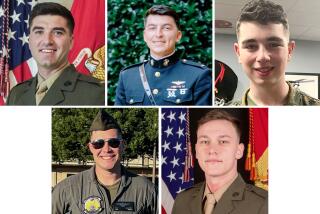Robert Galer, 91; Marine Pilot, Medal of Honor Winner
- Share via
Retired Brig. Gen. Robert E. Galer, who earned the Medal of Honor for daring aerial victories in the South Pacific as a Marine squadron leader during World War II, died of a stroke Monday at a Dallas hospital. He was 91.
During his command of the 244th Marine Fighter Squadron, Galer downed 11 enemy aircraft in 29 days over the Solomon Islands in 1942. He was shot down three times during World War II and once during the Korean War, surviving each time with little more than a few crushed ribs.
Humble about his record, he often referred to himself as simply “the luckiest old Marine around.”
His death leaves 121 living Medal of Honor recipients.
Galer, a Seattle native, was an engineering major and All-American basketball player at the University of Washington. He joined the Marines right after obtaining his bachelor’s degree in 1935. Inspired by his childhood hero, Charles Lindbergh, he became a naval aviator.
In December 1941, Galer was stationed at Pearl Harbor, Hawaii, when Japanese planes swooped down on the American forces. With all their planes on fire, Galer and his fellow pilots were handed rifles and fired futilely at the incoming Zeros, the nimble Japanese fighter planes used in thousands of kamikaze attacks during the war. When the rest of his squadron was sent to Wake Island, he remained at Pearl Harbor as the only qualified landing signal officer in the Pacific.
In August 1942, he was dispatched to Guadalcanal as commander of the 244th fighter squadron. Badly outnumbered, he and his team were engaged in ferocious aerial combat every day over the next month but scored an impressive record, in part because of a strategy Galer helped devise.
Galer’s squadron flew the Grumman F4F Wildcat, which was outclassed by the superior Zeros in speed and agility. However, the American plane could match the Zero in a dive and had more firepower. Relying on Australian coast watchers who surreptitiously monitored the movements of Japanese forces, Galer ordered his Wildcats to climb to 28,000 feet and wait for word of approaching Zeros from a spotter watching the nearest Japanese airfield.
“He’d call every morning and say something like, ‘Twenty bombers and 20 fighters en route.’ And we’d scramble,” Galer recalled in a 2003 Dallas Morning News story.
The Marines learned to target the lead Japanese bomber because if it went down, the planes behind it would drop their bombs and flee. Nonetheless, American losses were high, with many pilots blacking out at the high altitude or taking hits in their slower, heavier Wildcats after completing their dive.
Galer once shot down three planes in less than a minute. In all, he was responsible for 11 of his squadron’s 27 kills in September 1942. He shot down a total of 13 planes during the war.
The last time he was shot down he swam for an hour to reach land. Islanders found him in a heap on the beach, put him in an outrigger canoe and returned him to a Marine outpost on Tulagi. He reached his base the next day in time to halt his colleagues’ preparations for his memorial service.
Galer was awarded the Medal of Honor by President Franklin D. Roosevelt on March 24, 1943.
Afterward, he was grounded because his superiors did not want to risk the life of a Medal of Honor recipient. Although he wanted to fly missions, he instead trained spotters who worked with ground units to help Marine pilots find targets. He also participated in three D-day landings -- at Iwo Jima, Luzon and Okinawa.
He returned to the skies in Korea in 1952, striking North Korean targets so successfully that he was awarded the Distinguished Flying Cross.
During his career he also received the Navy Cross, the Legion of Merit with Combat V, the Purple Heart, an Air Medal with 10 Gold Stars and the British Distinguished Flying Cross.
Galer flew his last mission on Aug. 5, 1952, when he “did a dumb thing” after leading his unit on a successful raid. “We were bombing and when we finished,” he said, “I went back to take a picture. And this anti-aircraft gun, he nailed me.”
When he bailed from his plane, his foot caught on something and he smashed into the tail. He opened his parachute when he was only about 150 feet from the ground.
With several cracked ribs and a badly sprained shoulder, Galer landed 100 miles behind enemy lines. A Navy helicopter rescued him after jockeying over rugged terrain and having its instruments knocked out by anti-aircraft flak.
After being promoted to brigadier general, he worked on guided missile development until his retirement in 1957.
He lost five planes during his 23 years of service, all but one in combat. He crashed the fifth -- an F3F-2 -- in the waters off San Diego in 1940 when its engine failed during a test flight after repairs. He bailed out before it sank out of sight, and the Navy wrote off the plane as lost.
In 1990, Galer was reunited with the plane after it was discovered by sailors searching for a downed helicopter. Galer, who was present as it was pulled from the sea, said it was “like seeing an old friend.” The plane, one of the earliest to feature retractable landing gear, was missing a wing but was otherwise perfect, the only military model of the F3F-2 to survive the war years.
After leaving the military, Galer moved to Dallas as vice president of Ling-Temco-Vought, a conglomerate whose holdings include aerospace companies. He later worked in real estate as an executive at Bright & Co., owned by Harvey R. “Bum” Bright, former owner of the Dallas Cowboys.
He is survived by his second wife, Sharon Alexander Galer of Dallas; four children; a brother; and six grandchildren.



